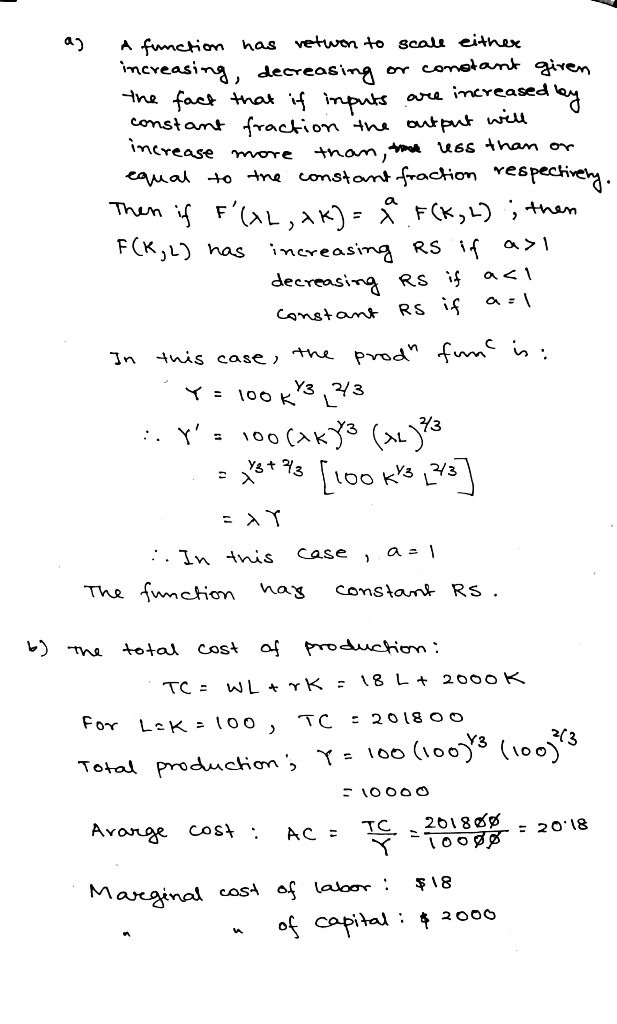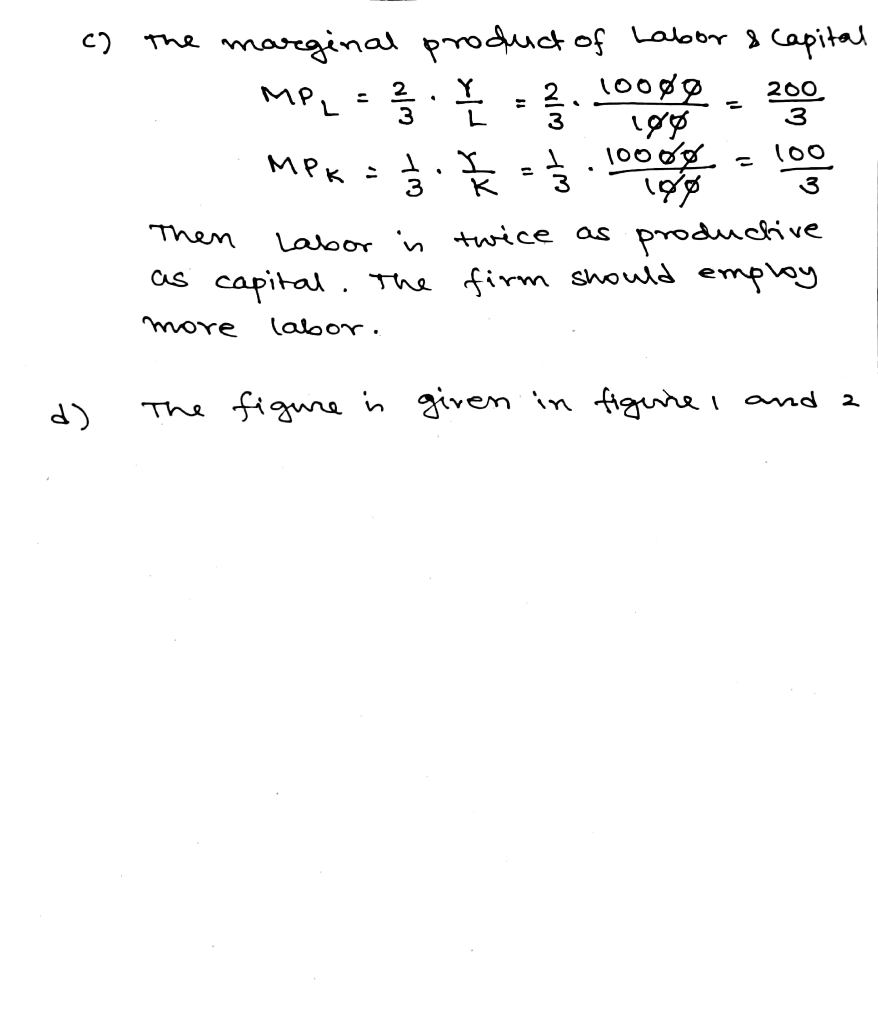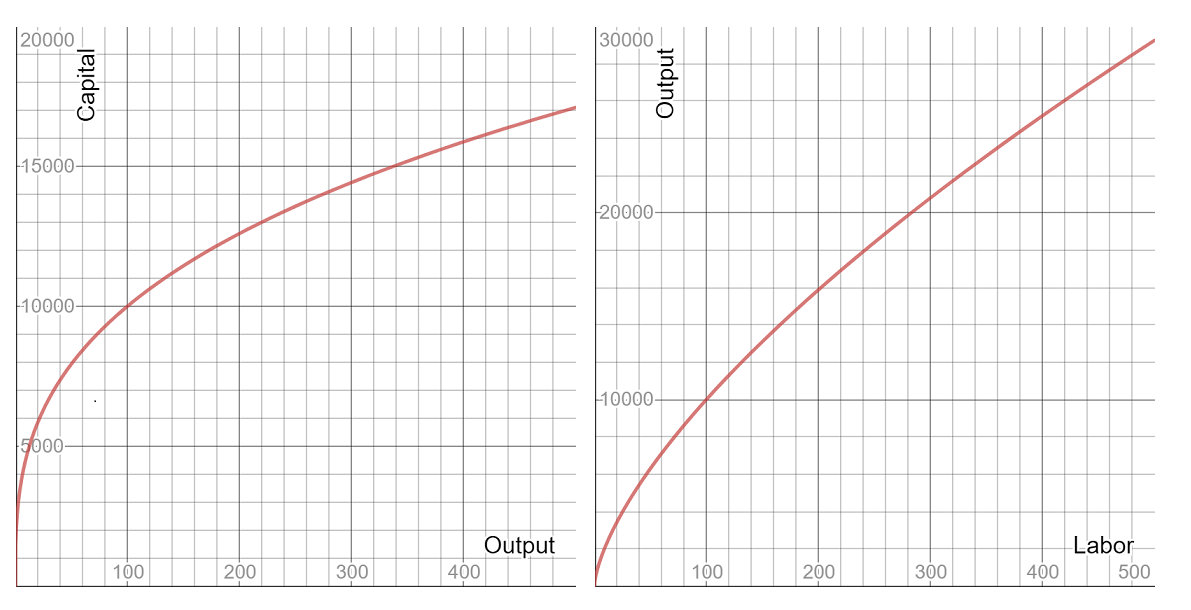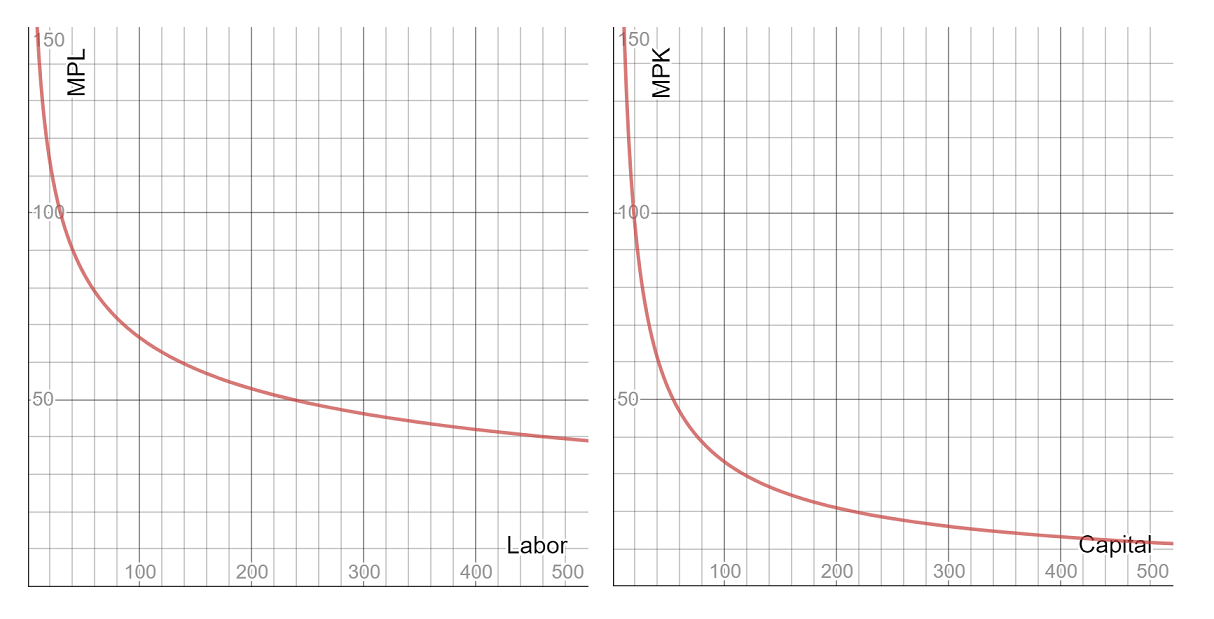Question
In: Economics
Suppose that you have the following production function: ? = (100?^1/3)*(?^2/3) Where k represents the units...
Suppose that you have the following production function: ? = (100?^1/3)*(?^2/3) Where k represents the units of capital employed at production, L is the number of labor hours employed for total production. The wage rate equals to $18 per hour. The cost of capital equals $2,000 per unit.
a) What are the returns of scale for this production function? Prove it
b) You are currently employing 100 hours of labor. Calculate your total costs, average cost and marginal costs of labor and capital if K=100 units.
c) Which input is more productive? Should you employ more labor or more capital?
d) Draw the production function, MPK and MPL for the different values of K and L.
Solutions
Related Solutions
Suppose that the production function is given by: ? = ?(?, ?) = ?(?)^1/3(?)^1/3 where ?...
Suppose that the production function is given by: ? = ?(?, ?) =
?(?)^1/3(?)^1/3
where ? > 0 is total factor productivity, ? indicates the
amount of capital employed and ? the amount of labor employed.
Wages are ? and the rental cost of capital is ?. Suppose that in
the short run capital is fixed, i.e., ? = ?bar. Moreover, the firm
must pay ??bar regardless of the production level
a) Solve the cost minimization problem. That is, determine...
assume a firm has the production function q=k^1/4L^1/4, where k represents capital, L represents labor, r...
assume a firm has the production function q=k^1/4L^1/4, where k
represents capital, L represents labor, r represents the price of
capital and w represents the price of labor.
Using the Lagrange method, derive the optimal quantities of k
and l as a function of q,r,w
Suppose a production function is given by F ( K , L ) = K 1 2...
Suppose a production function is given by F ( K , L )
= K 1 2 L 1 2, the price of capital “r” is $16, and the price of
labor “w” is $16.
a. (5) What combination of labor and capital minimizes the cost of
producing 100 units of output in the long run?
b. (5) When r falls to $1, what is the minimum cost of producing
100 pounds of pretzels in the short run? In the long...
2. Suppose a production function is given by F ( K , L ) = K 1...
2. Suppose a production function is given by F ( K ,
L ) = K 1 2 L 1 2, the price of capital “r” is $16, and the price
of labor “w” is $16.
a. (5) What combination of labor and capital minimizes the cost of
producing 100 units of output in the long run?
b. (5) When r falls to $1, what is the minimum cost of producing
100 pounds of pretzels in the short run? In the...
A plant’s production function is Q = L^1/3 K^2/3, where L is hours of labor and...
A plant’s production function is Q = L^1/3 K^2/3, where L is
hours of labor and K is hours of capital. The price of labor
services, w, is $40 per hour and of capital services, r, is $10 per
hour.
a. Derive the long-run expansion path. In words describe what
the expansion path represents.
b. In the short-run, the plant’s capital is fixed at K = 64.
Labor, on the other hand, is variable. How much will it cost to...
Suppose the production function for high-quality bourbon is given by Q = (K · L)1/2 where...
Suppose the production function for high-quality bourbon is
given by Q = (K · L)1/2 where Q is the
output of bourbon per week and L is labor hours per week. Assume
that in the short run, K is fixed at 144. Then, the short-run
production function becomes:
Q = 12L(1/2)
(A) If the rental rate of capital is $12 and wages are
$9 per hour, obtain the short-run total costs
function.
(B) If the SMC
for this firm is...
2. Consider a firm with the following production function: Q = K 1/3 L 2/3 (a)...
2. Consider a firm with the following production function: Q = K
1/3 L 2/3
(a) Consider an output level of Q = 100. Find the expression of
the isoquant for this output level.
(b) Find the marginal product of labor, MPL. Is it increasing,
decreasing, or constant in the units of labor, L, that the firm
uses?
(c) Find the marginal product of capital, MPK. Is it increasing,
decreasing, or constant in the units of capital, K, that the...
Suppose Canada’s aggregate production function is given by the following: Y = (K*1^3)(N*2^3) Variables are defined...
Suppose Canada’s aggregate production function is given by the
following:
Y = (K*1^3)(N*2^3)
Variables are defined as they were in class. Suppose the savings
rate in Canada is 33.33% (s = 1 3) and the depreciation rate is 15%
(δ = 0.15). Assume that Canada is not currently experiencing any
technological change.
a) Calculate the steady-state level of capital per worker
and output per worker in Canada’s economy.
b) Determine the annual growth rate of output per
worker in Canada....
Suppose a production function is given by F ( K , L ) = K^(1/2) L^(1/2), the...
Suppose a production function is given by F ( K , L )
= K^(1/2) L^(1/2), the price of capital “r” is $16, and the price
of labor “w” is $16.
a. (5) What combination of labor and capital minimizes the cost of
producing 100 units of output in the long run?
b. (5) When r falls to $1, what is the minimum cost of producing
100 pounds of pretzels in the short run? In the long run?
c. (5) When...
Consider the following aggregate production function: Y=100×L×K, where A is the total factor productivity, K is...
Consider the following aggregate production function:
Y=100×L×K, where A is
the total factor productivity, K is the amount of capital
in the economy, L is the labour force, and Y is
the GDP.
Is this aggregate production function exhibiting the constant
returns to scale? Explain how you know. (2)
Is this aggregate production function exhibiting the
diminishing marginal product of capital? Explain how you know.
(2)
In 1867, the government employed 6% of the country’s workers.
Since then, the country’s...
ADVERTISEMENT
ADVERTISEMENT
Latest Questions
- Coors and Anheuser-Busch (Budweiser) are competing against each other to try to capture a larger share...
- a) How much heat is required to change a 31.3 g ice cube from ice at...
- Two hockey pucks are moving to the right with puck 1 behind puck 2. Puck 1...
- Imagine that you are in the following real life situation. You are working in the human...
- In the AD-SRAS-LRAS model, what happens to the price level and the unemployment level in the...
- Suggest a policy aimed at encouraging female workforce participation and briefly explain how it might achieve...
- Assume the branch manager is not satisfied with the widths of the obtained confidence intervals, and...
ADVERTISEMENT




 Rahul Sunny answered 3 weeks ago
Rahul Sunny answered 3 weeks ago